Here, we are only dealing with feed for adult laying chickens. (If you have an associated rooster, who is obviously NOT going to be laying a thing, he’s fine eating his harem’s food.)
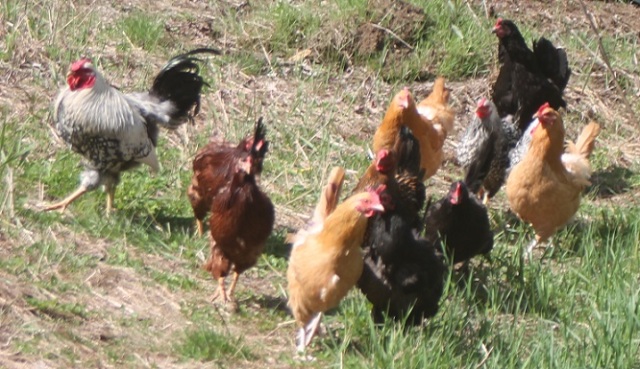
The flock coming up to greet the hands that feed them.
It is possible during the non winter months to feed your chickens primarily on what they forage, with supplemental grains. Some breeds forage better than others, but you can be pretty much assured that any heritage breed was developed whilst on forage.
My chickens don’t free-range during the snow season. Nothing for them to find and eat! They’re also not particularly endeared with the notion of snow or ice. So, during that time, their egg yolks are pretty much generic yellow, but you can do things to help them. The notes below are for mature laying hens (and of course their lone rooster eats what they eat, and is fine with it. In fact, he (at least here) often lets them eat first).

The feed I buy for my layers. Things that seem like “wahhhh?” are essential vitamins and minerals or yeast extracts. They also add in calcium, but always wise to supply your hens more – they’ll self-medicate.
- Do pick a good brand of chicken feed. I use Scratch and Peck organic layer feed, which is an organic brand of layer feed without soy. Of course, the number of hens you have and how much you are willing to spend may mean you will decide to use a brand that isn’t organic and/or which contains soy. BUT stay with “Layer Feed” – which provides the proper amount of protein and other nutrients (especially calcium) to encourage the production of healthy eggs in adult hens. Stay with feed intended for chickens, not necessarily duck or game birds, although some feeds are formulated to work for several. Look at packaging. Their requirements may differ. PS: I started my layers on layer food about week 16-18. Eggs generally will start appearing week 20 or so.
- How much to feed. About a third cup per bird per day, when not out on pasture. Or if you don’t have a significant amount of some of the food supplements listed below. Adjust otherwise.
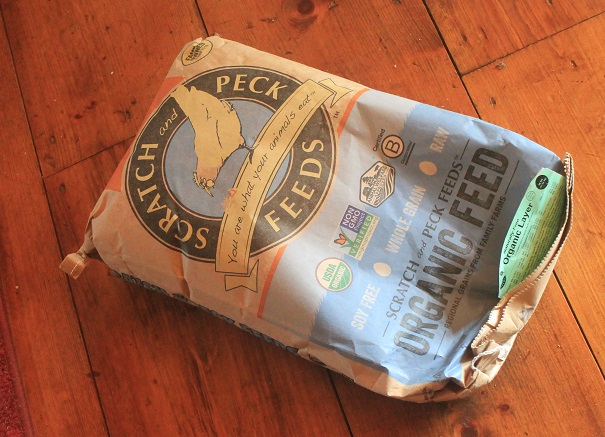
- This was recommended to me by a good online resource site. I buy this through Amazon, two 25 lb bags at a time. I will admit that if I were doing quantity chickens for egg sales, I might not go the organic, no soy route, due to price. But then again… depends on your area market. (I sell eggs at $3.50 a dozen, which is the market price in my area for home-farmed eggs.)
- Kitchen trimmings. Your hens can eat most any type of kitchen vegetable or fruit trimmings (exceptions below) as long as they aren’t moldy or rotten. Even though my hens get an organic poultry layer feed, I don’t necessarily have organic produce in my kitchen. I am not trying for organic certification for one. I also try not to buy the “Dirty Dozen” of the veggie world for any of us living here. But if the healthiest things they (or I) eat are organic, so it goes and so we do. They do seem to like the things I give them, by and large. Mine don’t seem fond of sweet potato peels. But they’ll eat them. Last.
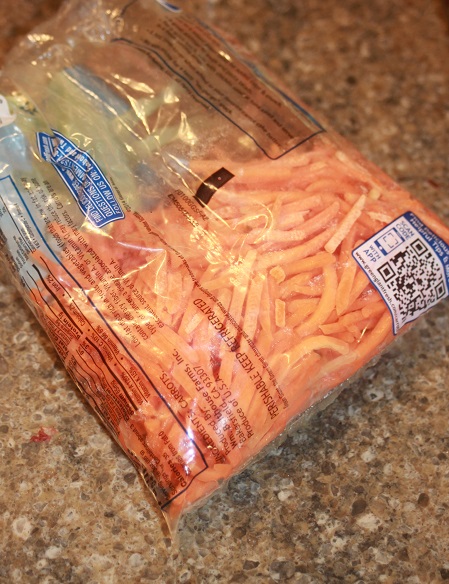
They like carrots more than I do.
- Kitchen scrap exceptions. Don’t feed them: Citrus peels, avocado peel, avocado stone, apple or other stone fruit cores/seeds (cyanide), green or budding potato parts, or chocolate. I’m not sure about this but just in case, I don’t feed them any part of the nightshade plants we humans aren’t supposed to eat.
- Kitchen scrap limitations. A minor amount of material from the allium family can be fed to them. But severely limit these, although some garlic has good antibacterial properties. A little goes a LONG way. Allium family members include garlic, onions, scallions/green onions, ramps, shallots and leeks.
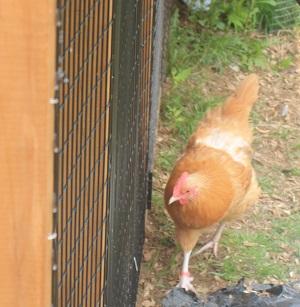
Idril, out foraging.
- Meats. Yes, chickens are omnivores. Out on the range they’ll eat grubs, ticks (YAY!!!), worms, and various other bugs that don’t get out of their way on wings. Some will even eat field mice that might visit their runs trying to nab some of that grain. Some breeds are more interested in being mousers than others. I’m told Buckeyes are very much mousers, but I don’t yet have personal evidence! (If either of my two Buckeyes have killed and eaten a mouse, they’ve effectively hidden the evidence…. I have seen the very occasional mouse track when snow blows into the run in winter, but I suspect the mice come at night, when the poultry is roosting/sleeping.) I supplement my ladies with mealworms and crickets (which you can purchase at a farm supply store – or you can be ambitious enough to grow your own for them); they seem to love mealworms and crickets even more so than they love grains, so I have to assume any tasty morsels of grubs and ticks they find out on pasture are snagged as soon as possible. I’ve made pork lard and lamb tallow cakes similar in shape and design to those wild bird cakes one finds in shops – one can embed them with roasted or raw pumpkin seeds, sunflower seeds, millet, mealworms, crickets, and other avian delicacies. Providing these in winter on an occasional basis (especially when the thermometer really dips) is really good to help them thermoregulate. This is also a great treat to amuse my hens when they can’t go outside. Check this recipe here, and feel free to adapt to materials at hand! I’ve also given mine some raw ground beef and ground lamb, which they’ve appreciated, but I don’t do this frequently. (Both of those ground meats came from local farmers; I’m not certain I’d give raw ground meat from a a supermarket sourced farm to anything…) And yes, you can feed your chickens… chicken. Though personally I’d cook this, no matter the source. I just haven’t done this yet. Feels just a bit cannibalistic to me… Whatever you do, do not salt food you provide to your chickens. Okay, a little ends up there, no big deal. However, they get enough from any foraging or feed they eat.
- Egg shells. Yes, if you use them, CRUSH THEM so they are unrecognizable as food. Actually, you should cook, boil or bake them to boiling temps (212 F / 100 C) for at least 5-10 minutes to sterilize them, too. I’ve been putting my egg shells into the compost bin with the other things I don’t feed my chickens, but your mileage might differ. (I buy them an oyster shell product, as mentioned elsewhere in the post.) Oh, I have given them cooked scrambled eggs when I’ve had some severely dirty eggs that I won’t feed to humans. (But never cracked dirty eggs – those I compost!)
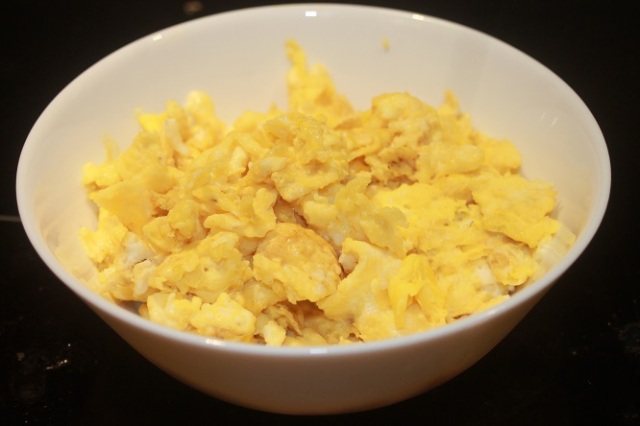
- Great chicken treats. In the heat of summer, I bought my chickens their own watermelon. I chilled it, chopped it up, and brought it out to them. At first, they just looked at it, and back at me… “WHA???” Then, one adventurous soul pecked at it, and when his compatriots saw he was overjoyed, they all dived in. They devoured everything but the very outer peel. I also hear they love grapes; next grocery run, I’m picking some up.
- To keep your chickens from being bored when you can’t let them range, hang things in those wild bird feeder cages – I use their lard/tallow treats in there, or sometimes I throw iceberg lettuce or red or green cabbage in them (sliced to fit). You can also pierce those cabbages with wire, thread some of that wire through there, and hang the cabbage up so they can peck at it that way.
- Grit/Gravel. Up here in New England, and probably most of the rest of the northern part of America and all of Canada, free ranging chickens will find a lot of grit or gravel on their own. Even so, I give them a supplemental choice, apart from their food per se. They eat as they choose (ad libitum) and pass the grit to their gizzards. The gizzards help digestion by grinding up their food, and those rocks in there do the majority of the work.
- Calcium. Yes, you can give them those aforementioned mashed up egg shells, but I also have a separate area where I can feed them pre-packaged and prepped oyster shell. I will say that my eggs are a LOT more solid than the generic supermarket egg I used to buy back in the day – cracking here happened in winter when the temperatures plummeted to 20 F and below (when eggs actually froze). The layer feed (most layer feeds, actually) do supply calcium as a matter of course, but having a separate feeding station for calcium allows the birds to monitor their own intake, and they are smart enough to do that, from everything I’ve observed.
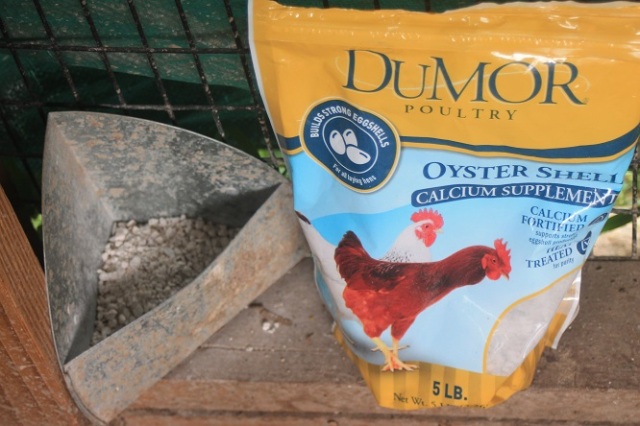
- Don’t spray your field with pesticides or herbicides if you let your hens forage. Okay, I spritz down my lower legs AT MY BACK DOOR with stuff to discourage ticks climbing up and around me, before going down to visit. While the hens do eat and depopulate ticks, they’re (alas) not coming up all the way to my house to feast. I am working on transitioning to a more healthy/natural method of tick-off-my-body control, but considering that deer ticks hereabouts can carry up to four really NASTY diseases, none of which I am enamored with experiencing, yep, I take precautions. (Found one of the little buggers climbing up my neck two nights ago… Not Remotely Happy…)
Since hens appear to lay eggs in the morning or the very early hours of afternoon, once I get the meat / broiler cockerels outdoors, I’ll be letting the cockerels out in the morning, and the layers out in the afternoon. Actually, since I’m not fond of impromptu Easter Egg Hunts, I’m doing that for the layers any how. The majority of the eggs will be laid in the coop earlier, and if I miss one or two afternoon surprises, so be it.
Stuff I hadn’t planned to talk about, but since it happened…
The other thing… I allowed a couple of my hens to go broody and nurse up eggs to hatching. While the first one to hatch had to be brought indoors for rearing (a couple reasons beyond the scope of this post), the second one is with her foster mama out in the coop and run. (Sad thing to note is that each broody hen had only one viable/surviving chick apiece. Three weeks apart, so the chicks aren’t going to run together, even if the second one had healthy feet.)
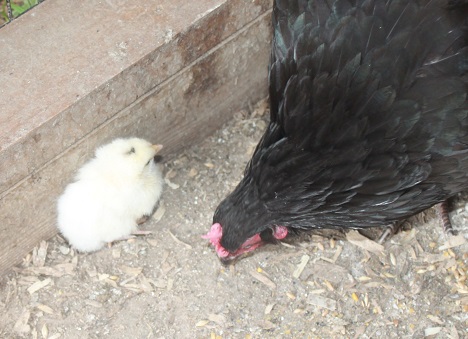
The little one seems to be named “Chickpea”. The chick is seen here with the foster mama – Yin. Less than a week old. Coloration – light with a black patch on the head, and darkness on the wings. Father: Silver laced Wyandotte. Genetic mother: one of the buff Orpingtons, but not Idril.
I’m not yet letting Mama out of the coop and run with her chick. Chick at this point is only a week old. But chick needs food! And the high protein of the starter chick food is important for its development. I distract the other adult hens (and the roo) by feeding the regular layer feed, then in a corner where Mama and Chick Child tend to hang out, I scatter some chick starter food. Oh, I discovered if I put a watering source UNDER the main watering source for the hens, those hens can’t get to it and drain it dry, but the baby can access it. Yay, team! Mama is really good at keeping the other adults at bay, as long as the other adults have food prior to me feeding the baby. Easy enough to arrange.
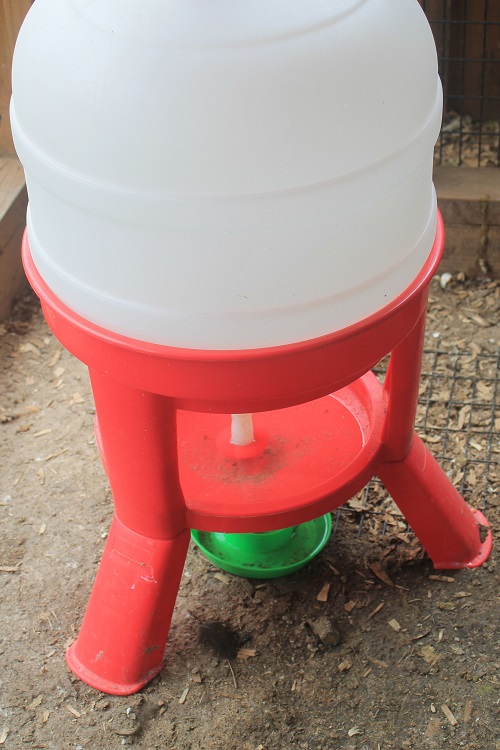
The baby chick’s water is beneath that for the hens. They preferentially don’t want to delve under, but the baby can access. (I’m not totally enamored of the larger system – it doesn’t always feed the water down as it should.)
Past Posts in this Series:
- Raising Chickens Part I: Intro & Overview
- Raising Chickens Part II: Welcoming Baby Chicks
- Raising Chickens Part III: Trekking to My Chickens in Zone 5 Winter
- Raising Chickens Part IV: My Chicken Run and Coop
- Raising Chickens Part V: The Bin, or Storage at Your Coop
- Raising Chickens Part VI: Feeding Those Layers
- Raising Chickens Part VII: Predation!
- Raising Chickens Part VIII: Is Organic the Way to Go?
Future Posts:
- Medical supplies and treatments for your chickens.
- Broody or Not?
- Recommended book, magazine and online sources for chicken learning!
Follow my Homesteading Page for 2019 updates as things happen here! Unfortunately, you won’t get notifications whenever I add a new date/addendum to that, so if you get a notification from the blog itself, do drop in to see. (PS I’d love conversation there, too.)
We are happy to link to:



 Sea Vegetable
Sea Vegetable
Pingback: Raising Chickens, Part V: The Bin, or Storage at Your Coop | Of Goats and Greens
Pingback: Raising Chickens, Part II: Welcoming Baby Chicks | Of Goats and Greens
Pingback: Raising Chickens Part IV: My Chicken Coop and Run | Of Goats and Greens
Pingback: Raising Chickens, Part I (Intro & Overview) | Of Goats and Greens
Pingback: Raising Chickens, Part III: Trekking to My Chickens in Zone 5 Winter | Of Goats and Greens
This is so interesting, I miss having my own hens. You are dong an amazing job and I am keeping all the posts for a friend who intends to get her own chickens.
Thank you! Chickens are fun and rewarding!
It’s fun to see how you are raising the baby chick with the adults. I have never done that. Keep up the good work and thank you for sharing your feeding information with us on Farm Fresh Tuesdays! Hope to see you again today!
I was wondering if I should separate the mama and the child from the rest of the flock, but I didn’t have a space where I could put them without stressing the mother too much. The other space I have is holding a hen that was henpecking her flock too much, But it seems to work out – Mama keeps everyone away from baby, and baby is quite good at dodging larger feet.
Pingback: Raising Chickens, Part VIII: Is Organic the Way to Go? | Of Goats and Greens
Pingback: Raising Chickens, Part VII: Predation! | Of Goats and Greens